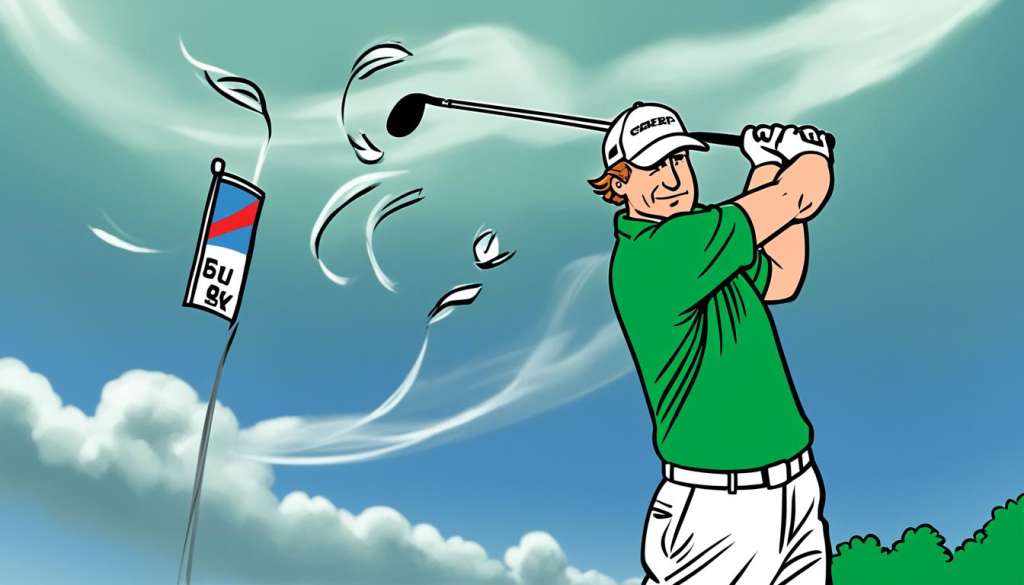Mastering golf course management can greatly improve your game. It’s about making smart moves from start to finish. Every choice you make affects your score and how much fun you have.
Start by understanding the course’s layout and hazards. This helps you pick the right club and place your shots wisely. Making smart decisions can lower your scores and make the game more enjoyable.
How the course is maintained affects your strategy too. Well-kept fairways and greens make playing easier. But rough and bunkers need careful planning. Adjust your game to match the course’s challenges.
Golf isn’t just about physical skills. It’s also about staying mentally sharp, controlling your emotions, and making quick decisions. Improving these skills helps you handle the game’s ups and downs better.
Understanding Golf Course Management
Golf course management is key to improving your game. It’s about planning and making smart choices on the course. Let’s explore what makes this skill so important.
Definition and Importance
Golf course management means using strategies for each hole. It’s about picking the right clubs, planning your shots, and adjusting to the course. This skill is crucial for better scores and more fun on the course. It also helps you understand the course design, leading to smarter decisions.
Impact on Scoring
Good course management can really lower your scores. By making smart choices, you avoid risks and play to your strengths. This leads to fewer mistakes and more consistent play. Knowing the layout and challenges of each hole helps you handle hazards better.
Key Elements of Effective Management
To get better at golf course management, focus on these key points:
- Study the course layout to spot challenges
- Pick the right club for each shot, considering distance and obstacles
- Think about the risks and rewards of bold play
- Adjust your strategy for weather conditions like wind and rain
Using these tips will help you make better decisions and boost your game. Remember, good course management also means caring for the environment and managing your budget. This ensures the courses stay great for everyone.
Tee Box Tactics: Setting the Stage
Your tee box strategy is key to a great game. Making smart choices here can change your whole round. Let’s look at some tips to boost your game from the start.
Choosing the right club is vital, but a 3-wood or 5-wood might be better sometimes. These clubs offer more control and straighter shots. This helps you hit the fairway more often.
Think about the hole’s layout when picking your tee spot. Go for the side that gives you the best angle to the fairway. This simple tip can greatly improve your second shot chances.
Wind direction is crucial for aiming. If it’s strong, aim your shot into the wind. This keeps your ball on course and stops it from going off track.
- Aim for the wider part of the fairway
- Factor in hazards when planning your shot
- Consider using an iron for tight fairways
The aim is to set up for success on your next shot. Playing safe from the tee can lead to better scores later. Try these tee box tactics and see your game get better.
Navigating Fairways and Rough
Mastering fairway management and rough navigation is key to lowering your scores. Let’s look at strategies for handling different course situations. These tips will help improve your game.
Choosing the Right Club
When in the fairway, pick comfort over distance. Start with your favorite fairway wood for long shots to feel confident. This keeps your shots controlled and consistent.
Dealing with Hazards
Avoiding hazards is crucial. Opt for safe shots that keep you out of trouble. Sometimes, giving up distance is better to save strokes later.
Playing from Difficult Lies
When the rough is tough, aim to get back to the fairway. Try a knockdown shot or a smaller swing for better control. These methods help you get through the rough and set up your next shot for success.
- Use a higher lofted club for better ball contact
- Grip down on the club for more control
- Adjust your stance to match the lie
By focusing on fairway management, rough navigation, and hazard avoidance, you’ll get better at managing the course. Remember, smart play often beats aggressive strategies in golf.
Approach Shot Strategies
Mastering approach shots is key to lowering your golf scores. When targeting the green, aim for more than just the pin. Think about the whole green and potential hazards.
For better green targeting, aim for the “percentage side” of the green. This means picking an area with more room for error. Avoiding tucked pins and hazards reduces the risk of getting stuck.
Pin placement is crucial in your approach strategy. If the pin is in a tough spot, aim away from it. Go for the green’s center or the side with more space. This approach might give you a longer putt but lowers the risk of a big mistake.
If you can’t reach the green, lay up to your best pitching distance. This could be 50, 75, or 100 yards, depending on your comfort with your short game. This sets you up for a confident approach to the green.
Use technology to improve your approach shots. GPS devices or rangefinders give accurate distances, helping you choose the right club. Knowing the exact yardage is key to precise shots and a better game.
Green Reading and Putting Techniques
Learning how to read greens and putt is key to lowering your golf scores. These skills can change your game, turning three-putts into one-putts and saving strokes.
Understanding Green Slopes
Start by looking at the green’s slope. Walk around it to see its shape from different views. Notice any subtle changes in slope that could affect your putt.
Choosing the Right Line
After checking the green’s slope, pick your putting line. Aim for the high side of the hole if you can. This makes uphill putts easier to control. Visualize where the ball will go and stick with your choice.
Mastering Speed Control
Controlling the speed of your putt is as crucial as the direction. Practice hitting putts to various targets on the practice green. Aim to get the ball to stop close to the hole, even if it doesn’t go in.
| Putting Technique | Key Focus | Benefit |
|---|---|---|
| Green Reading | Slope Analysis | Better Line Selection |
| Aim Selection | High Side of Hole | Increased Make Percentage |
| Speed Control | Distance Practice | Fewer Three-Putts |
Adjust your putting strategy based on the green and your skills on any day. With regular practice of these techniques, you’ll see your golf game and scores improve.
Golf Course Management Guide: Advanced Tips
Want to boost your golf skills? Learn advanced strategies like shot shaping and deep course analysis. These skills will greatly enhance your game on the green.

Shot shaping is key for advanced play. Practice controlling your ball’s path with draws and fades. This skill helps you dodge obstacles and place your ball where you want on the fairway.
Understanding the course layout is also vital. Study each hole to spot hazards and the best spots to aim for. This knowledge helps you plan your shots and avoid risks.
- Practice controlling ball flight for various wind conditions
- Develop a backup swing for off days
- Analyze your common misses and adjust targets accordingly
Adjusting to different course conditions is crucial. Keep an eye on weather, seasonal changes, and course-specific challenges. These factors can change your strategy and club choice.
| Course Condition | Strategy Adjustment |
|---|---|
| Windy day | Lower ball flight, adjust aim |
| Wet fairways | Less roll, club up |
| Fast greens | Softer putting stroke |
Advanced golf strategy isn’t just about physical skills. It also requires mental focus and smart decision-making. Stay sharp, believe in yourself, and always have a backup plan for tough situations.
Managing Risk vs. Reward Scenarios
Golf is all about making smart choices. Every shot is a decision between playing safe or going for the win. Knowing how to balance risk and reward is key to doing well on the course.
When you’re thinking about a risky shot, look at your current form and confidence. If you’re hitting well, you might want to take a chance. But if you’re not feeling confident, playing it safe is usually better.
Experts in golf psychology say it’s often better to avoid big mistakes than to aim for birdies. Sometimes, playing it safe and aiming for bogey can save your score. This approach can lead to more consistent rounds and lower scores.
Factors to Consider in Risk-Reward Scenarios
- Your current score and position in the round
- Course layout and potential hazards
- Weather conditions
- Your skill level with specific shots
- The potential outcomes of aggressive vs. conservative plays
Not every shot needs to be a bold move. Making smart choices means knowing when to push yourself and when to play it safe. By getting better at this, you’ll manage the course better and lower your scores.
| Scenario | Risk Level | Potential Reward | Recommended Strategy |
|---|---|---|---|
| Par 5, reachable in two | High | Eagle opportunity | Go for it if playing well, lay up if struggling |
| Short par 4, water in front of green | Medium | Birdie chance | Consider driving green if confident, otherwise lay up |
| Par 3, tucked pin position | Low | Birdie opportunity | Aim for center of green, avoid chasing difficult pin |
Adapting to Course Conditions
Golf courses change with the weather, seasons, and local conditions. To improve your game, learn how to adapt to these changes. This includes understanding weather, seasons, and the specific challenges of each course.
Weather Considerations
Wind is a big factor in golf. On windy days, use lower lofted clubs and aim for a low ball flight. In hot weather, the ball goes farther, so pick your clubs wisely. Rain makes the course longer, so you’ll need more club.

Seasonal Changes
Seasons change how you play golf. In spring, greens are soft and welcoming. Summer makes fairways firmer, causing the ball to roll more. Fall brings leaves that can affect your shot. Winter golf is tough with hard ground and slow greens.
Course-Specific Challenges
Every golf course is different and requires a special strategy. Links courses need shots that run low to fight the wind. Parkland courses want precise tee shots because of the trees. Desert courses are tricky with their sandy areas.
| Course Type | Key Strategy | Common Challenges |
|---|---|---|
| Links | Low trajectory shots | Wind, undulating fairways |
| Parkland | Accurate tee shots | Tree-lined fairways, water hazards |
| Desert | Precise club selection | Sandy waste areas, extreme heat |
To get better at golf, study the course, know the weather, and adapt your game. By doing this, you’ll be ready for any course and improve your game.
Mental Game and Decision Making
Golf psychology is key to your success on the course. A strong mental game can change your whole game. Let’s look at how to improve your decision-making and keep your emotions in check during play.
Creating a pre-shot routine helps keep you focused and consistent. This routine should be easy and consistent. Take a deep breath, picture your shot, and stick with your choice. Using visualization can greatly improve how you hit your shots.
It’s important to manage your feelings after bad shots or holes. Every golfer has tough times. Instead of getting stuck on mistakes, focus on the next shot. Positive thoughts can boost your confidence and keep you in a good mood all round.
Your decisions should be based on how you’re feeling and what you can do well, not just what you think you should do. Be honest about your skills and play to your strengths. This way, you’ll make better shot choices and score lower.
| Mental Game Element | Technique | Benefit |
|---|---|---|
| Pre-shot Routine | Deep breathing, visualization | Improved focus and consistency |
| Emotional Control | Positive self-talk, mindfulness | Better composure under pressure |
| Decision Making | Realistic assessment, playing to strengths | Smarter shot selection, lower scores |
By using these golf psychology tips, you’ll get better at making decisions and staying calm on the course. Practice these skills often to see your game improve.
Technology and Tools for Course Management
Golf technology has changed how we manage the course. GPS devices and advanced analytics help golfers make better choices. Let’s see how these innovations can boost your game.
GPS Devices and Rangefinders
GPS devices are now key for accurate distance checks. They give you the exact yardages to hazards, greens, and more. Rangefinders work like them, using laser tech for distance. Knowing the exact distance lets you pick the right club and hit with confidence.
Course Management Apps
Golf apps have changed course management a lot. They offer detailed maps, track your shots, and give strategic tips. Some apps use AI to pick clubs based on your history. These apps help you plan and make better shots during play.
Data Analysis for Improvement
Golf analytics are a big deal for serious players. They track your progress, showing what you’re good at and what needs work. By looking at data on driving, approach shots, and putting, you can practice smarter. Some systems even track your swing, helping you improve your technique.
| Technology | Benefits |
|---|---|
| GPS Devices | Accurate distance measurements, hazard awareness |
| Course Management Apps | Strategic planning, shot tracking, club suggestions |
| Golf Analytics | Performance tracking, targeted practice, technique improvement |
Using these tech tools gives you deep insights into your game. They help you make smarter choices on the course. Keep an eye on new golf tech as it comes out, offering more ways to improve your game.
Conclusion
Golf improvement is all about mastering course management. By using strategic play, you can lower your scores and enjoy the game more. Every decision you make from the tee box to the green affects your performance.
Smart golfers focus on their strengths and avoid taking big risks. They change their strategies based on the course, weather, and their own skills. This way, they get more consistent and lower scores over time.
Golf is a journey of continuous learning. As you use these strategies, you’ll see your game get better. Keep learning, stay patient, and your hard work will show in your scores. With practice and smart choices, you’ll become more confident and skilled on any course.

